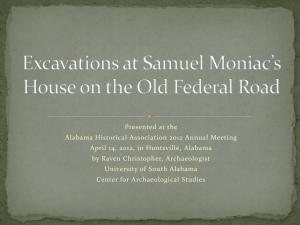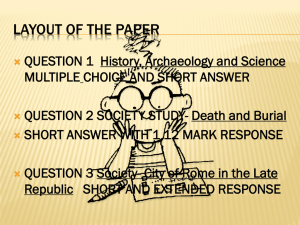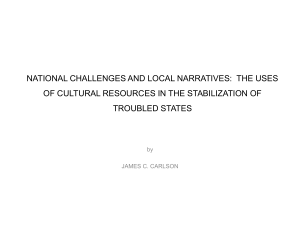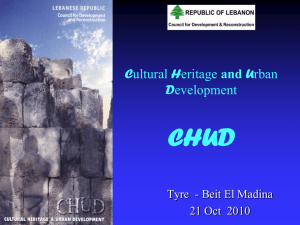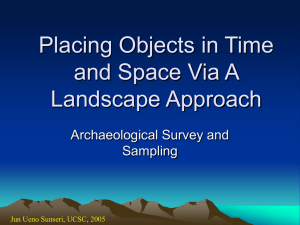GAMMA-OMEGA 765 Kv TRANSMISSION LINE
advertisement
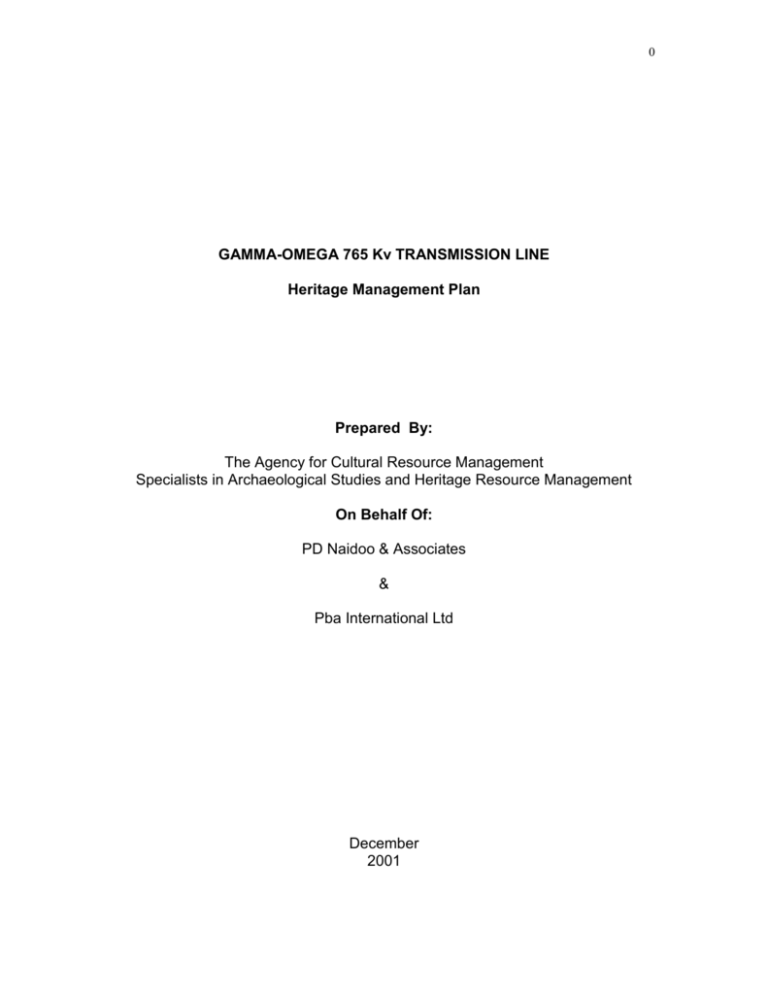
0 GAMMA-OMEGA 765 Kv TRANSMISSION LINE Heritage Management Plan Prepared By: The Agency for Cultural Resource Management Specialists in Archaeological Studies and Heritage Resource Management On Behalf Of: PD Naidoo & Associates & Pba International Ltd December 2001 1 TABLE OF CONTENTS Page 1.0 INTRODUCTION .................................................................................................................. 2 1.1 Background ............................................................................................................................ 2 2.0 TERMS OF REFERENCE .................................................................................................... 2 3.0 CONSTRAINTS ASSUMPTIONS AND LIMITATIONS ........................................................ 2 4.0 OPPORTUNITIES AND BENEFITS ..................................................................................... 3 5.0 THE STUDY AREA ............................................................................................................... 3 6.0 STUDY APPROACH ............................................................................................................ 4 6.1 Method ................................................................................................................................... 4 7.0 LEGISLATION ...................................................................................................................... 4 8.0 RESULTS OF THE FIELD REVIEW AND DESK TOP STUDY ........................................... 4 8.1 Archaeological sites ............................................................................................................... 4 8.1.1 Section 1 ......................................................................................................................... 4 8.1.2 Section 2 ......................................................................................................................... 5 8.1.3 Section 3 ......................................................................................................................... 5 8.1.4 Section 4 ......................................................................................................................... 6 8.1.5 Section 5 ......................................................................................................................... 6 8.2 Palaeontological sites ............................................................................................................ 7 8.2.1 Section 1 ......................................................................................................................... 7 8.2.2 Section 2 ......................................................................................................................... 7 8.2.3 Section 3 and 4 ............................................................................................................... 7 8.2.4 Section 5 ......................................................................................................................... 7 8.3 Historical sites ........................................................................................................................ 8 8.3.1 Section 1 ......................................................................................................................... 8 8.3.2 Section 2 ......................................................................................................................... 9 8.3.3 Section 3 ....................................................................................................................... 10 8.3.4 Section 4 and 5 ............................................................................................................. 10 9.0 `RED FLAG' AND `NO GO' AREAS ................................................................................... 10 9.1 Archaeology ......................................................................................................................... 10 9.1.1 Section 1 ....................................................................................................................... 10 9.1.2 Section 2 ....................................................................................................................... 10 9.1.3 Section 3 ....................................................................................................................... 10 9.1.4 Section 4 ....................................................................................................................... 10 9.1.5 Section 5 ....................................................................................................................... 10 9.2 Palaeontology ...................................................................................................................... 11 9.2.1 Section 1 ....................................................................................................................... 11 9.2.2 Section 2 ....................................................................................................................... 11 9.2.3 Section 3 ....................................................................................................................... 11 9.2.4 Section 4 ....................................................................................................................... 11 9.2.5 Section 5 ....................................................................................................................... 11 9.3 Historical .............................................................................................................................. 11 9.3.1 Section 1 ....................................................................................................................... 11 9.3.2 Section 2 ....................................................................................................................... 11 9.3.3 Section 3 ....................................................................................................................... 11 9.3.4 Section 4 ....................................................................................................................... 11 9.3.5 Section 5 ....................................................................................................................... 12 10.0 IMPACT DESCRIPTION AND ASSESSMENT .................................................................. 12 10.1 Section 1 ............................................................................................................................ 12 10.2 Section 2 ............................................................................................................................ 12 10.3 Section 3 ............................................................................................................................ 12 10.4 Section 4 ............................................................................................................................ 13 10.5 Section 5 ............................................................................................................................ 13 11.0 RECOMMENDED MANAGEMENT ACTIONS ................................................................... 13 12.0 REFERENCES ................................................................................................................... 16 2 1.0 INTRODUCTION 1.1 Background PD Naidoo & Associates and Pba International, requested the Agency for Cultural Resource Management to undertake a heritage review of the proposed Eskom Transmission Gamma-Omega 765kV Transmission Line between the proposed Gamma (Victoria West) and Omega substation (Koeberg) sites, as a basis for the Environmental Management Plan for the project. Known as the Cape Strengthening Programme, the proposed project includes a range of services that will improve the reliability of electricity supply to the Western Cape. The aim of the study was to assess the potential impact that the proposed 765kV-Transmission line will have on archaeological, palaeontological and historical sites along the proposed routes. 2.0 TERMS OF REFERENCE The terms of reference for the heritage review were: 1. to identify sites of archaeological, palaeontological and cultural status in the study area; 2. to assess the likelihood of sensitive sites in the study area; and 3. to identify measures to protect from construction damage any valuable archaeological, palaeontological and cultural sites that may exist in the proposed powerline route. 3.0 CONSTRAINTS ASSUMPTIONS AND LIMITATIONS The following constraints, assumptions and limitations apply to the heritage review. The review was severely constrained by a limited field study, which allowed only a cursory assessment of the proposed routes. The field study focused only on the archaeological status of the proposed routes, and to a limited extent on the historical status of the proposed routes. 3 4.0 Information on the palaeontological (fossil) status of the proposed routes was obtained from Dr Roger Smith of the Department of Karoo Palaeontology at the South African Museum (Cape Town) and from Dr Dave Roberts of the Council for Geoscience (Cape Town) and it is assumed that this information is correct. OPPORTUNITIES AND BENEFITS The proposed Eskom Transmission Gamma-Omega 765kV project presents considerable opportunities and benefits for heritage specialists. These include: the opportunity to identify and record previously unknown heritage sites. the opportunity to identify mitigatory measures to protect and maintain any valuable archaeological, palaeontological and historical sites that may exist in the proposed routes. 5.0 THE STUDY AREA The study area for the project is illustrated in Map 5a. Four routes are proposed. These include: the Central Route: this being the total route from the proposed Gamma substation to the proposed Omega substation, including the proposed new route over the Agter Witsenberg area; the Central Alternative: this being the short section through the Agter Witsenberg area; the Northern Alternative: this being the section deviating to the north in Section 3 and joining at the Gydo Pass; and the Southern Alternative: this being the section following the existing 400 Kv lines past Ceres and Wolsley. 4 6.0 STUDY APPROACH 6.1 Method In order to address the objectives of the heritage review, the following method has been followed: a 4-day site assessment of the proposed routes. a desk top review. consultation with specialists. 7.0 LEGISLATION Archaeological and palaeontological sites, graves/cemeteries, battlefield sites, and buildings, structures and features over 60 years old, are protected under the National Heritage Resources Act (No. 25 of 1999). According to the Act, it is an offence to destroy, damage, excavate, alter of remove from its original place, or collect, any archaeological, palaeontological and historical material or object, without a permit issued by the South African Heritage Resources Agency (SAHRA). 8.0 RESULTS OF THE FIELD REVIEW AND DESK TOP STUDY 8.1 Archaeological sites 28 location sites in Sections 1-5 of the proposed routes were visited and searched for archaeological remains. 8.1.1 Section 1 Four locations were searched in Section 1. No archaeological remains were located, but relatively large numbers of Middle Stone Age1 (MSA) and Early Stone Age2 (ESA) artefacts have been found during a number of heritage impact assessments undertaken in the Swartland and Berg River region (Hart 1987; Kaplan 1988, 1999, 2000a,b, 2001a,b,c,d). 1 2 A term referring to the period between 200 000 and 20 000 years ago. A term referring to the period between 2 million and 20 000 years ago. 5 Two Later Stone Age3 (LSA) sites occur on the farm Groot Oliphantskop, the site of the proposed Gamma substation (Kaplan 1996). Two Khoisan skeletons were also excavated from a large sand dune on the farm about 50 years ago (Kaplan 1996). Large parts of Section 1 are currently heavily farmed, resulting in low archaeological visibility. Voelvlei and Driebos Shelters (between the Central Route and the Southern Alternative), are located in the Voelvlei Mountains overlooking Voelvlei Dam. The upper levels of Voelvlei Shelter are radiocarbon dated to between 300 and 400 years ago (Smith et al 1991) and a dating to the early period of European contact was confirmed by the finding of a glass bead, a lump of lead, a fragment of an iron nail and a copper bead. 8.1.2 Section 2 Four locations were searched in Section 2, including one in the Central Alternative. Bushman rock paintings are well known in the Koue Bokkeveld region of Section 2, particularly those depicting colonial imagery (Johnson et al 1959; Yates et al 1993). The Koue Bokkeveld was unusual in terms of early Cape history, in that unlike many other areas from which the Khoisan quickly disappeared, there was sustained contact in the region between remnants of the Khoisan and colonists throughout the eighteenth century (Penn 1987). No archaeological remains were located during the Section 2 field review. 8.1.3 Section 3 Six locations were searched in Section 3. These included the farms Lower Stinkfontein, Platfontein and four unknown farms along the proposed Central Route. Relatively large numbers of MSA tools, and some LSA tools were found on the farm Lower Springfontein. A few MSA few tools were located on the farm Platfontein. The proposed Northern Alternative was not searched for archaeological remains. No detailed archaeological studies have been undertaken in the Section 3 study area. 3 A term referring to the last 20 000 years of precolonial history in southern Africa. 6 8.1.4 Section 4 Five locations were searched in Section 4. These included the farms Klipfontein, Swaerskraal, Spitzkop, Fortuin and Bon Espirange. A few MSA tools were located on the farms Swaerkraal and Fortuin. No detailed studies have been undertaken is this area (David Morris McGregor Museum, Kimberley, pers. comm.). 8.1.5 Section 5 Nine locations were searched in Section 5. These included the farms Gabriels Baken, Phaisant Kraal, Tyboschfontein, Montana, Steenrotsfontein, La-De-Da, Vindragersfontein, Buffels Valley and Rietpoort. Archaeological remains were located at four of the nine sites visited; at Phaisant Kraal, Steenrotsfontein, La-De-Da, and Buffels Valley. These included a handful of mainly MSA and some ESA tools, but a discreet, low density scatter of LSA tools and some ostrich eggshell were located on the farm La-De-Da. According to David Morris of the McGregor Museum in Kimberley (pers. comm.), no heritage impact assessments have been undertaken in Sections 5 or 4 of the study area. But other studies have shown that scatters of stone tools are abundant around Victoria West and in the Upper Karoo and the Orange River Scheme (Goodwin & Van Riet Louw 1926; Jansen 1926; Humphreys 1979; Sampson 1972, 1984). The Karoo in Sections 4 and 5 rocks are shot through by dolerite dykes, where the raw material hornfels/indurated shale is ubiquitous and superabundant and an excellent source for making stone tools (Parkington 1984). Bushman rock paintings and rock engravings have also been recorded at Pampoempoort near Victoria West and in the Karoo National Park (Morris pers. comm.). 7 8.2 Palaeontological sites According to Dr Roger Smith of the Department of Karoo Palaeontology at the South African Museum in Cape Town, Sections 2-5 in the study area all fall within sensitive fossil bearing deposits. 8.2.1 Section 1 According to Dr Dave Roberts of the Council for Geoscience in Cape Town, Section 1 comprises the Malmesbury Group of deposits. Body fossils of Malmesbury age are known from elsewhere (e.g. Namibia), but the geological setting (deep water turbodites) of Section 1 is highly unfavourable for body or plant fossils. No fossils of any sort have yet been found in the Malmesbury Group (Roberts pers. comm.). 8.2.2 Section 2 Section 2 falls within the Bokkeveld Formation, which is an extremely sensitive area for invertebrate fossils dating to about 380-410 million years ago. Extensive outcroppings in Ceres, Gydo Pass and Tulbach have produced rich fossil remains (Smith pers. comm.). 8.2.3 Section 3 and 4 Section 3 and 4 falls in the Whitehill and Ecca Group of deposits respectively, which are rich fish and plant fossil-bearing deposits. Extensive outcroppings of these deposits occur around the Matjiesfontein and the De Doorns area, but extending further inland too, toward Sutherland and Komsberg (Smith pers. comm.). 8.2.4 Section 5 Section 5 is located in the Karoo Supergroup, made up primarily of sandstones and shale (known as the Beaufort Group). The area around Beaufort West for example, is the richest collecting ground for mammal and reptile-like fossils (or Karoo vertebrates) in the world. The fossils found in this area are approximately 250 million years old. The upper escarpment, kopjes, ancient river valleys and washouts, are all sensitive areas and considered to be highly collectable fossil sites (Smith pers. comm.). Fossils have been found on a number of farms in the study area, including Rietfontein, Waaikraal, Kuilspoort, La-De-Da and Spitskop. Vindragersfontein is a well-known locality where extensive collections have been done (Smith pers. 8 comm.). The Karoo National Park outside Beaufort West is also well known for its rich diversity of fossils 8.3 Historical sites Historical sites refer to buildings, graves, cemeteries, built structures and features in the landscape which have historical significance. 8.3.1 Section 1 The Groot Oliphantskop homestead is located on the site of the proposed Gamma substation (Kaplan 1996). Built with `opgekleide' walls, possibly around the late eighteenth or early nineteenth century, the farmhouse currently retains a T-form shape, but was originally L-shaped or even straight. Also of interest is a building behind the main house with riet ceilings, reputed to be older than the main house. (Kaplan 1996). Despite being altered both internally and externally over time, the farm complex is considered conservation worthy (David Hart, South African Heritage Resources Agency, pers. comm.). Additional historical features on the farm include two stone lined wells and an old cemetery. The Mamre Road also passes through the farm, and although not a declared national monument, has been declared conservation-worthy by the South African Heritage Resources Agency (Hart pers. comm.). According to the addendum to the Gamma-Omega draft scoping report (2001:3435) the old transport route over the Porseleinberg may be impacted by the proposed Central Route. No evidence of the route was noted during the field study, and the route has most likely been destroyed by farming and related activities. The Central Route also passes over a dilapidated Cape Dutch thatched-roof farmhouse on the farm Koomandsdrif on the Porseleinberg Road. The proposed Central Route in Section 1 passes south of nearby Sonquasdrift, a ford across the Berg River that was used by the Dutch as was one of the routes used to gain access to the mountains and the Tulbach valley to the east. It remained an important Dutch outpost in the eighteenth century (Deacon 1993). In May 1701, it was attacked by the Ubiqua Khoikhoi who drove away most of the Dutch cattle (Smith et al 1991). 9 Bushmans Rock near Gouda is a prominent flat topped sandstone outcrop situated alongside the railway line (in the Central Route). It is here, at the entrance to Tulbach Kloof, in 1738, that the head and right hand of Ettienne Barbier, a Dutch renegade, was staked on a pole, as a warning to offenders, not to undermine the authority of Cape Dutch rule (Mossop n.d.). The Southern Alternative in Section 1 will very likely impact on the `sense of place' of the historic farm Bartholomeus Klip. The earliest buildings on the farm, including the Cape Dutch homestead known as Bosplaas, date to around the 1700's. The outbuildings on the farm, which include the stone built sheds and storerooms, were constructed around the 1800's. According to farm manager, Mike Gregor (pers. comm.), visitors to the guest farm already comment on the unsightly feature of the existing 400 Kv Transmission line. 8.3.2 Section 2 The farm Elandsfontein on the Op Die Berg-Citrusdal road, occurs in the proposed Northern Alternative. The farm complex may be significant, and a number of buildings, including the homestead, have been renovated and restored. Sensitive historical sites were also visited at Steinthal and Slagterspad (Tulbach) in the Central Alternative and Central Route respectively. The Steinthal mission settlement was established for freed Cape slaves in 1843 (Dominee Dreyer, pers. comm.). It has the customary thatched and whitewashed cottages, several of which are in bad condition. Most of the buildings were destroyed in the earthquake of 1969 (Fransen and Cooke 1980). The remaining building (currently the community library) was declared a national monument in 1999. The addendum to the Gamma-Omega draft scoping report (2001:34-35) reports that there are historically sensitive sites in the Agter Witsenberg mountains, including a VOC canon (dated ± 1734), and the remains of a British fort. According to Dominee Dreyer (pers. comm.), the old wagon trail to Wuppertal is also located in the mountains behind Steinthal. In 1658, Sergeant Jan van Harwarden led an expedition on behalf of Jan van Riebeek to find a way through the mountains in order to access the fabled gold fields of Monomotapa. Thus Slagterspad (or Oude Kloof) between Gouda and Tulbach was built, and is reputed to be one of the oldest mountain passes in the country (Mossop n.d). 10 8.3.3 Section 3 The Karoopoort Outspan (declared a national monument in 1981), is located alongside the Southern Alternative on the R46. The outspan, comprising a werf wall enclosing two buildings (a thatched roof langhuis and a large rectangular outhouse with tin roof), was used by early travellers to the north and was described by Burchell (1822). 8.3.4 Section 4 and 5 No known historical sites occur in the proposed Central route (David Morris, McGregor Museum, Kimberley, pers. comm.). Unknown South African AngloBoer war graves may, however, occur in the study area. 9.0 `RED FLAG' AND `NO GO' AREAS A sensitivity map for cultural heritage resources is illustrated in Map 5. 9.1 Archaeology 9.1.1 Section 1 The Porseleinberg is regarded as a Moderate to High `Red Flag' area. 9.1.2 Section 2 The Bokkeveld, Agter Witsenberg and Ceres mountains are regarded as Moderate to High `Red Flag' areas. 9.1.3 Section 3 The low-lying mountains on the western boundary of Section 3 are regarded as a Moderate `Red Flag' area. 9.1.4 Section 4 The Komsberg and Moordernaars Karoo are regarded as a Moderate to High `Red Flag' area. 9.1.5 Section 5 The mountainous areas of the Great Karoo are regarded as a Moderate to High `Red Flag' area. 11 9.2 Palaeontology 9.2.1 Section 1 No `Red Flag' or `No Go' areas occur in Section 1 (Dave Roberts pers comm.). 9.2.2 Section 2 Section 2 is regarded as a Moderate to High `Red Flag' area (Roger Smith, pers. comm.). 9.2.3 Section 3 Section 3 is regarded as a Moderate to High `Red Flag' area (Roger Smith, pers. comm.). . 9.2.4 Section 4 Section 4 is regarded as a Moderate to High `Red Flag' area (Roger Smith, pers. comm.). 9.2.5 Section 5 Section 5 is regarded as a Moderate to High `Red Flag' area (Roger Smith, pers. comm.). 9.3 Historical 9.3.1 Section 1 Groot Oliphantskop, Koomandsdrif, Bartholomeus Klip and Bushmans Rock are all regarded as Moderate to High `Red Flag' areas. 9.3.2 Section 2 Slagterspad/Oude Kloof, Steinthal, the Agter Witsenberg, and the Ceres Mountains, are regarded as Moderate to High `Red Flag' areas. 9.3.3 Section 3 The Karoopoort Outspan is regarded as a `Red Flag' area. 9.3.4 Section 4 No `Red Flag' or `No Go' areas occur in Section 4. 12 9.3.5 Section 5 No `Red Flag' or `No Go' areas occur in Section 5. 10.0 IMPACT DESCRIPTION AND ASSESSMENT A summary of the significance of the archaeological, palaeontological and historical impacts is presented in Tables 1,2 and 3. Impact assessment descriptions of the archaeological, palaeontological and historical impacts are presented in Tables 4-30. 10.1 Section 1 Archaeology - other than the Porseleinberg, the potential impacts in Section 1 are regarded as Low. Palaeontology - the potential impacts in Section 1 are regarded as Low. Historical - other than the farms Groot Oliphantskop and Koomandsdrif, and Bushmans Rock and Slagterspad/Oude Kloof in the Central Route, and Bartholomeus Klip farm in the Southern Alternative, the potential impacts in Section 1 are regarded as Low. 10.2 Section 2 Archaeology - the potential impacts in Section 2 are regarded as High-Medium. Palaeontology - the potential impacts in Section 2 are regarded as High Historical - the potential impacts in Section 2 are regarded as High-Medium. 10.3 Section 3 Archaeology - the potential impacts in Section 3 are regarded as High-Low. Palaeontology - the potential impacts in Section 3 are regarded as High. Historical - other than the Karoopoort Outspan in the Southern Alternative, the potential impacts in Section 3 are regarded as Low. 13 10.4 Section 4 Archaeology - the potential impacts in Section 4 are regarded as High-Low. Palaeontology - the potential impacts in Section 4 are regarded as High. Historical - the potential impacts in Section 4 are regarded as Low. 10.5 Section 5 Archaeology - The potential impacts in Section 5 are regarded as High-Low. Palaeontology - The potential impacts in Section 5 are regarded as High. Historical - The potential impacts in Section 5 are regarded as Low. 11.0 RECOMMENDED MANAGEMENT ACTIONS With regard to the archaeological heritage, the following management actions, to be included in the Environment Management Plan, are required. 1. The tower positions in Sections 2-5 should be checked by a professional archaeologist. 2. All proposed new access roads in Sections 2-5 should be checked by a professional archaeologist. 3. All proposed borrow pits and quarries should be checked for archaeological remains. 4. Methods of mitigation could also be determined following pegging of the final route and discussion with the Environmental Control Officer (ECO). 5. A full-time Environmental Control Officer (ECO) is required along the route alignment during vegetation clearing. 6. The ECO is to be briefed by a professional archaeologist what to look out for, particularly during bush clearing. 7. Contractors, staff and plant operators should also be briefed what to look out for, particularly during bush clearing and the construction phase of the project. 14 8. Heritage remains uncovered or disturbed during bush clearing and earthworks should not be disturbed until inspected by the ECO and a professional archaeologist. 9. Heritage remains should be verified by the ECO during the course of bush clearing. 10. Should any human remains be disturbed, exposed or uncovered during earthworks, these should immediately be reported to the consultant archaeologist, or the office of the South African Heritage Resources Agency (SAHRA) in Cape Town. Contact Mrs Mary Leslie on (021) 462 4502. Burial remains should be treated sensitively at all times. Human remains should not be removed until inspected by a professional archaeologist. With regard to the palaeontological heritage, the following management actions, to be included in the Environment Management Plan, are required. 1. A pre-digging survey of the preferred route, all proposed new access roads and tower site locations, in Sections 2-5, is required. 2. All excavation trenches/cuttings, borrow pits and quarries in Sections 2-5 are to be inspected for fossil remains. 3. Dr Roger Smith of the Department of Karoo Palaeontology at the South African Museum in Cape Town (021 424 3330) should be consulted further with regard to the potential palaeontological impacts arising out of the proposed project. 4. Methods of mitigation could also be determined following pegging of the final route and discussion with the Environmental Control Officer. 15 With regard to the historical heritage, the following management actions, to be included in the Environment Management Plan, are required. 1. Mr David Hart, Acting Regional Manager of SAHRA, is to be consulted with regard to potential impacts arising out of the proposed project. These include possible impacts on the `sense of place' on the farms Groot Oliphantskop, Koomandsdrif and Bartholomeus Klip in Section 1, Elandsfontein and Steinthal in Section 2, and the Karoopoort Outspan in Section 3. Mr Hart can be contacted on (021) 462 4502. 2. Additional methods of mitigation can be determined following the planning and design of the preferred route. The above recommendations are subject to approval of the South African Heritage Resources Agency. 16 12.0 REFERENCES Burchell, W.J. 1822. Towards the interior of Southern Africa. London. Longman, Hurst, Rees. Deacon, J. 1993. Management guidelines for rock art sites in nature conservation areas and forestry reserves in the Western Cape. Report prepared for the Department of Environmental Affairs and Tourism. Fransen, H. & Cooke, M.A. 1980. Old buildings of the Cape. AA Balkema. Gamma-Omega 765kV Transmission Line Environmental Impact Assessment Addendum to the Draft Scoping Report October 2001. Prepared for Eskom Transmission by PD Naidoo & Associates (Pty) Ltd, pba International & Acer (Africa). Hart, T. 1987. Porteville survey. In Parkington, J. & Hall, M. (eds.). Papers in the prehistory of the Western Cape, South Africa. Oxford: BAR International Series 332:404-423. Hart, T. 1989. Haaskraal and Volstruisfontein: Later Stone Age events in the Great Karoo, Unpublished MA thesis, University of Cape Town Humphreys, A. J, B. 1979. The Holocene Sequence of the Northern Cape and its position in the prehistory of South Africa. Unpublished Ph.D. thesis: University of Cape Town. Johnson, R.T., Rabinowitz, H & Sieff, P. Rock paintings at Katbakkies, Koue Bokkeveld, Cape. South African Archaeological Bulletin 14: 99-103. Kaplan, J. 1996. Archaeological and cultural impact assessment, Omega substation. Report prepared for Ninham Shand Consulting Engineers. Kaplan, J. 1998. Archaeological study, portion 5 of the farm Boontjiesrivier No. 262, Tulbach. Report prepared for Mr E. Spiers. Kaplan, J. 1999. Archaeological study, proposed low cost housing project, Kalbaskraal. Report prepared for CK Rumboll & Associates. Kaplan, J. 2000a. Archaeological and historical study, Sout River catchment management plan. Report prepared for Steffen Robertson and Kirsten. Kaplan, J. 2000b. Archaeological study, portions 9, 10 and 11 of the farm Uitkamp No. 189, Durbanville. Report prepared for First Plan Town and Regional Planners. 17 Kaplan, J. 20001b. Heritage Impact Assessment, proposed development, Glen Rosa Country Estate, Paarl. Report prepared for Doug Jeffery Environmental Consultants. Kaplan, J. 2001c. Heritage Impact Assessment, proposed Nooitgedacht water supply project. Report prepared for Diane Erasmus Environmental Services. Kaplan, J. 2001d. Heritage Impact Assessment, Kalbaskraal and Chatsworth/Riverlands Access Roads. Report prepared for Megan Anderson Landscape Architect. Mossop, E.E. n.d. Old Cape Highways. Maskew Miller, Cape Town. Parkington, J. 1984. Changing views of the Later Stone Age of South Africa. Advances in World Archaeology 3:89-140. Penn, N. 1987. The frontier in the Western Cape, 1700-1740. In: Parkington, J.E. and Hall, M. (eds.) Papers in the prehistory of the Western Cape, South Africa:462-503. Oxford: British Archaeological Reports. Sampson, C.G. 1972. The Stone Age industries of the Orange River Scheme and South Africa. Memoirs of the National Museum Bloemfontein 6:1-283. Sampson, C.G. 1984. Site clusters in the Smithfield Settlement pattern. South African Archaeological Bulletin 39:5-23. Smith, A.B., Sadr, K., Gribble, J. & Yates, R. 1991. Excavations in the southwestern Cape, South Africa and the archaeological identity of prehistoric huntergatherers within the last 2000 years. South African Archaeological Bulletin 46:7191. Yates, R., Manhire, A. & Parkington, J. 1993. Colonial era paintings in the rock art of the south-western Cape: some preliminary observations. South African Archaeological Society Goodwin Series 7:59-70.


